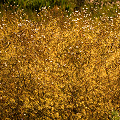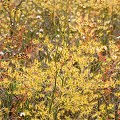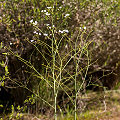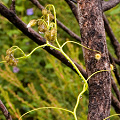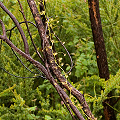| The Tuberous Erect & Scrambling Drosera | |
|---|---|
|
Erect species D. andersoniana1 D. auriculata2,4,5 D. basifolia1 D. bicolor2,4 D. bulbigena1 D. calycina1 D. esperensis1 D. geniculata1 D. gigantea1 D. gracilis2,4 D. graniticola1 D. heterophylla1 D. hookeri2,4,6 D. huegelii var. huegelii1 D. huegelii var. phillmanniana1 D. lunata2,4,7 D. marchantii1 D. menziesii1 D. microphylla1 D. myriantha1 D. neesii1 |
D. peltata2,4,8 D. prophylla1 D. radicans1 D. salina2 D. stricticaulis1 D. sulphurea1 D. yilgarnensis2,4 D. zigzagia2 Scrambling species3 D. drummondii D. eremaea D. erythrogyne D. hirsuta D. indumenta D. intricata D. macrantha D. modesta D. moorei D. pallida D. planchonii D. subhirtella D. thysanosepala |
|
1Species in Drosera section Ergaleium 2Species in Drosera section Luniferae 3Species in Drosera section Macrantha 4A member of the "D. peltata complex". 5Occurs in southeastern Australia, Tasmania, New Zealand. 6Occurs in southeastern Australia, Tasmania. 7Occurs in eastern Australia, Indonesia, Philippines, South Korea, Vietnam, Cambodia, Thailand, Myanmar, India, Sri Lanka, China (inc. Taiwan), Nepal, Japan; possibly west from Nepal to Tajikistan. 8Occurs in eastern Australia (New South Wales, Australian Capital Territory, Victoria, Tasmania; possibly Queensland). |
|
Q: The tuberous erect & scrambling Drosera
A: This last group of tuberous species, comprise plants which have very elongated and wiry stems.
The leaves along the stem are produced singly or in whorls of three.
The "erect" species have a stiff stem that can support the plant's weight, although it might topple in wind. Even
these erect species often lean against nearby grasses, twigs, and shrubs. Leaves along the stem are peltate, while those
in the basal rosette (if present) are paddle-shaped, and look like those of more familiar species such as
D. rotundifolia.
The "scrambling" species (sometimes called "climbing") have extremely long stems that cannot possibly
support their weight. They are vinelike in habit. The leaves along the stem are sometimes very dimorphic. Two of the leaves
in each whorl are on short petioles, while the third leaf is on a very long petiole. The long-petioled leaves grab onto
vegetation and cement themselves in place. This keeps the plant adhered to the supporting structures. (Some erect species share
this adaptation.)
Species in this section span a great range in size. Tiny D. microphylla lives up to
its name ( "micro-leaves"), while D. gigantea is an enormous, 1-meter plant with a
treelike outline. Scrambling species can be even longer than a meter, but instead of being shrublike, they are more ropelike in structure.
Drosera basifolia
A plant that is quite similar to Drosera menziesii, but
it has densely clustered leaves surrounding the base of the stem.
Drosera drummondii
Formerly known as D. menziesii subsp. penicillaris.
Drosera erythrogyne
This is an excellent representative of the scrambling species. It is a very long-stemmed plant
that I have seen climbing high into the branches of trees. This giant's
stem can be 3 meters long!
Drosera gigantea
Truly a plant to reset your scale when you think about big sundews. This plant is shaped like a small tree, with a thick
stem and long, many-branched arms. The white flowers are scattered about the top of the plant. It is amazing to see.
The tubers of this plant can be a meter below ground, but manage to reach the surface every year by using the same vertical
access tunnel.
Drosera heterophylla
This species really intrigues me because it
produces flowers with several petals. This is unique in the entire genus---all other Drosera normally
produce flowers with only four or five petals (the occasional mutant flower aside).
Drosera hookeri
A species that Robert Gibson et al. has pulled out of the Drosera peltata
swirling mass of confusing taxa. This species is similar to D. peltata but is multi-branched. It is
robust, with stems 1-2 mm in diameter, which help distance the plant from the similar D. bicolor. Sometimes
referred to, incorrectly, as D. foliosa.
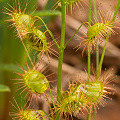 Drosera marchantii
Drosera marchantii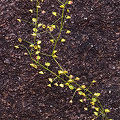 Drosera macrantha
Drosera macrantha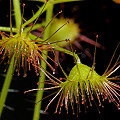 Drosera macrantha
Drosera macrantha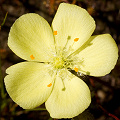 Drosera intricata
Drosera intricata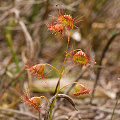 Drosera huegelii
Drosera huegelii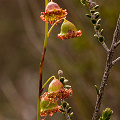 Drosera huegelii
Drosera huegelii
Drosera huegelii
This is one of my favorite species in the group because of its bizarrely bell-shaped leaves. Each little erect plant may only
have a few to a dozen leaves. It seems to put a lot of faith in the prey-catching ability of each of those leaves!
The variety phillmanniana, named after a friend of many of us, who left far far too soon, is notable for having stems
consistently on the short side. Phill was consistently on the short side (if you know what I mean).
Drosera intricata
This winding plant is named after its convoluted, twining stem.
Drosera lunata
Similar to Drosera auriculata, but with seeds that are
ovoid or peanut-shaped, or in any event they are shorter than 1mm long. The report of "Drosera insolita" is attributed to this, and a clerical error.
Drosera macrantha
A glandular, climbing species. I have seen specimens climbing other plants, dead trees, twigs, and even rock walls.
Drosera marchantii
This graceful, erect sundew looks very much like some of the fan-leaved species. Only upon close inspection can you be sure
that the leaves are peltate and not fan-leaved.
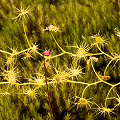 Drosera modesta
Drosera modesta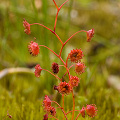 Drosera microphylla
Drosera microphylla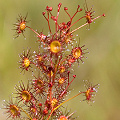 Drosera menziesii
Drosera menziesii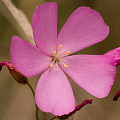 Drosera menziesii
Drosera menziesii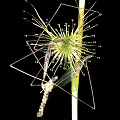 Drosera auriculata
Drosera auriculata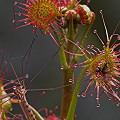 Drosera auriculata
Drosera auriculata
Drosera menziesii
A very common plant in southwestern Australia, in fact on my one trip to that part of the country
I learned to treat it as a plant to walk past in search of rarer things. (Sounds terribly spoiled, doesn't it?)
Overall reddish, even the erect subspecies are at most a weakly erect plant.
Drosera microphylla
A small plant with tiny flowers where the petals are dwarfed by the sepals.
The plants from the Perth area have red petals, those from Albany have orange petals, and on some
of the plants east of Esperance they are white.
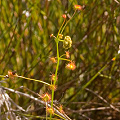 Drosera sulphurea
Drosera sulphurea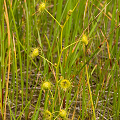 Drosera stricticaulis
Drosera stricticaulis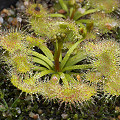 Drosera peltata
Drosera peltata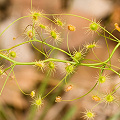 Drosera pallida
Drosera pallida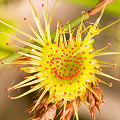 Drosera neesii
Drosera neesii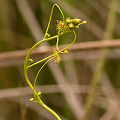 Drosera neesii
Drosera neesii
Drosera peltata
One of the two most commonly grown tuberous Drosera.
This plant is the center of much debate. Some researchers, including ones with enormous field research and whom I respect greatly,
have broken the "D. peltata complex" into several species:
D. auriculata, D. bicolor, D. gracilis,
D. hookeri, D. lunata, D. peltata,
and D. yilgarnensis.
There are a number of characters separating these plants, but very briefly, they can best be distinguished by the
the following characters:
D. auriculata: glabrous sepals, linear seed longer than 1 mm.
D. bicolor: unbranched habit, bicolored flowers.
D. gracilis: narrow stem (0.5mm), normally leafless on distal half, red foliage.
D. hookeri: glabrous or hirsute sepals, style with 15-25 segments, branching habit.
D. lunata: glabrous sepals, ovoid seed shorter than 1 mm.
D. peltata: pubescent sepals, style with 15-25 segments, ovate seed, unbranched habit, red basal rosettes.
D. yilgarnensis: pubescent sepals, style with 30-60 segments, SW Australia.
Drosera stricticaulis
A species with green-glandular stems and cup-shaped leaves. Overall, a very yellow-green plant and fairly recognizable.
Drosera sulphurea
A plant that has been considered synonymous with Drosera neesii, but now is placed
as a separate species. One of the yellow-flowered species.
Drosera yilgarnensis
Formerly considered to be a population of Drosera peltata in Western Australia.
Page citations: Gibson, R.P. et. al. 2010;
Gibson et al. 2012;
Lowrie, A. 1987, 1989, 1999, 2005, 2013; Lowrie, A. et al. 2017a, 2017b;
Rice, B.A. 2006a; Robinson, A. et al. 2017; Schlauer, J. 1996, 2002; Taton, A. 1945; Utz, Y.-A., and Gibson, R. 2017.
